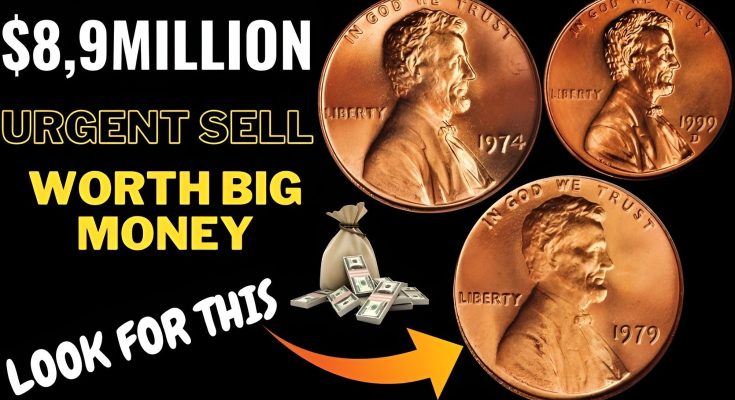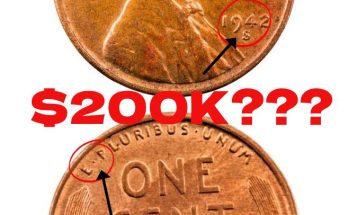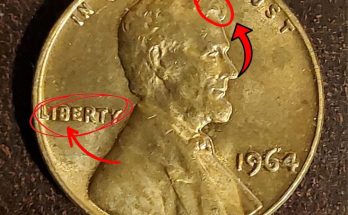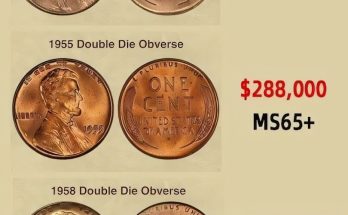The humble penny, America’s one-cent coin, is often dismissed as pocket clutter. Most of us don’t even bother to pick one up off the street. But as the image suggests, the penny’s value can be far greater than its copper-plated appearance lets on. While billions have been minted, a small number of these coins are genuine treasures, holding stories of historical rarity, minting errors, and legendary collector demand. The images of the 1974, 1999, and 1979 pennies in the photo hint at the lucrative nature of modern coin hunting, but it is the true numismatic legends that can turn a simple coin into a fortune.
Here are five of the most valuable cent coins that you should absolutely never spend—and what to look for if you want to find one of your own.
1. The 1943 Copper Penny
The 1943 cent is perhaps the most famous and valuable error coin in U.S. history. During World War II, copper was a critical material needed for ammunition and wartime production. To conserve it, the U.S. Mint switched the composition of the penny from its traditional bronze (95% copper) to zinc-coated steel. However, a small number of bronze planchets—the blank metal discs used to strike coins—were left in the coin presses at the Philadelphia, Denver, and San Francisco Mints. These were accidentally struck with the 1943 date.
The result is a numismatic legend. Finding a 1943 penny that is not steel is the ultimate prize for a coin hunter. You can easily test for this by using a magnet. If the penny sticks, it’s a common steel cent. If it does not, you might have a million-dollar coin on your hands. Only about 40 of these copper-alloy cents are known to exist, and one 1943-D (Denver) example sold for over $1.7 million at auction, securing its spot as one of the most valuable pennies of all time.
2. The 1909-S VDB Lincoln Cent
This coin is a classic “key date” and a cornerstone of any serious Lincoln cent collection. It was the first year of the Lincoln cent design, which was introduced to commemorate Abraham Lincoln’s 100th birthday. The coin’s reverse featured the initials of its designer, Victor David Brenner (“V.D.B.”). However, public outcry over the prominent placement of the initials led the Mint to remove them a few months after the coin’s release.
The “S” mint mark, indicating the coin was struck in San Francisco, is what makes this specific penny so valuable. The San Francisco Mint produced a very limited number of the 1909 VDB cents—only 484,000. When combined with the public’s initial demand for the new coin, this low mintage created an instant rarity. While not as expensive as a 1943 copper cent, a 1909-S VDB in high-grade condition can easily be worth thousands of dollars, making it a legendary coin.
3. The 1955 Doubled Die Obverse
The 1955 Doubled Die cent is the most recognizable error coin in the world. The error occurred when the coin’s die received a misaligned double strike during the creation process, causing the date and lettering to appear as if they were printed twice. The result is a dramatic, easily visible doubling on the date and the words “LIBERTY” and “IN GOD WE TRUST.”
Tens of thousands of these coins were accidentally released into circulation, with many of them ending up in vending machines that couldn’t handle the thicker, doubled coin. This coin became an immediate sensation among collectors and is often the first “big find” many hobbyists dream of making. Because the doubling is so prominent, this coin’s authenticity is easy to verify, and even well-worn examples can fetch hundreds of dollars, while uncirculated examples can be worth several thousand.
4. The 1914-D Lincoln Cent
Another product of low mintage, the 1914-D is a true rarity and a testament to the value of careful scrutiny. With a mintage of just 1,193,000, this coin is exceptionally scarce, especially in higher grades. At the time, the Denver Mint was not a major producer of coins, and few of its cents were saved in uncirculated rolls.
Finding a 1914-D penny is a challenge in itself, but finding one in great condition is even more so. While a low-grade, circulated example might be worth around $100, an uncirculated specimen can sell for many thousands of dollars. The 1914-D is a quiet giant in the world of valuable pennies—it lacks a flashy error but more than makes up for it with its rarity and historical significance.
5. The 1969-S Doubled Die Obverse
Even rarer than the 1955 doubled die is its 1969-S counterpart. This coin’s story is one of intrigue, as the U.S. Secret Service initially confiscated a number of these coins, believing them to be counterfeits. They were later proven to be genuine mint errors.
The doubling on the 1969-S is much more subtle than on the 1955, and often requires a magnifying glass to be seen on the words “LIBERTY” and “IN GOD WE TRUST.” But what it lacks in visibility, it makes up for in value. Only a handful of these coins are known to exist, making it one of the most valuable post-1960 U.S. coins. With auction prices often reaching into the tens of thousands of dollars, this penny proves that the biggest treasures can be the hardest to find.
While the pennies in the accompanying photo—the 1974, 1999, and 1979—might not be as valuable as these five coins in their standard forms, they are popular hunting grounds for various modern errors, such as the 1974 aluminum cents, or “Wide AM” and other doubled die varieties. This highlights a key lesson for any aspiring coin hunter: whether old or new, every penny has the potential to hold a hidden fortune. So, look closely, learn the key dates and errors, and you might just find a million-dollar coin.



